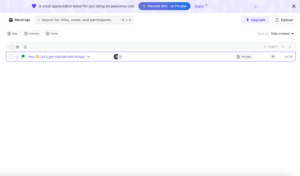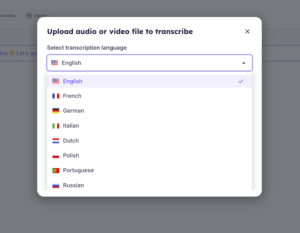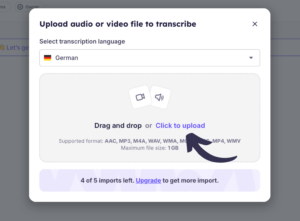How do you transcribe voice memos to text? Remember how challenging it was to write down every word your lecturer said? Now, you’re trying not to miss a word from your boss—those days are over. With Krisp, all you need to do is download the app, and your transcription worries vanish. Krisp introduces a game-changing tool that lets you transcribe audio or video files directly in your Krisp web account. This feature complements the AI Meeting Assistant, enabling you to transcribe live meetings and generate summaries afterward.
In this guide, we’ll show you how to transcribe your voice memos to text on your iPhone or other devices for free using a few simple methods.
How Do You Transcribe Voice Memos To Text?
Let’s start with what transcribing means. Transcribing is the process of converting spoken words from an audio or video recording into written text. A good example of transcribing is writing down lectures or the work done by a court transcriptionist. Transcribing requires accurately typing every word you hear, making it different from note-taking, which is a more subjective activity. In note-taking, two people attending the same meeting may highlight entirely different tasks or information, as the process involves selectively recording certain details while potentially omitting others.
The process of transcription is quite interesting:
Choose Your Tool: There are free and paid transcription tools. Paid ones offer better accuracy and quality.
Prepare Your Audio: Ensuring clear audio is crucial for accurate transcription. Background noises, echoes, and rustling can significantly hinder the transcription process. Krisp’s Noise Cancellation tool addresses this issue by eliminating unwanted sounds, resulting in pristine audio quality. By filtering out distractions, Krisp enhances the clarity of your recordings, leading to more precise transcriptions.
Upload or Play the File:
- If using a transcription app, upload your voice memo directly into the app.
- If using live dictation tools (like Google Docs Voice Typing), play the voice memo aloud near your device’s microphone.
Review and Edit: Automated transcriptions are often about 80-90% accurate, so review the text for any mistakes.
Save and Organize: Once satisfied with the transcription, save the file in your preferred format (e.g., PDF, DOCX) and organize it in your notes or document storage.
Transcribe Apple Voice Memo to Text
If you are an Apple user, pay attention to this section. Apple Voice Memos make it easy and convenient to record ideas, meetings, or quick reminders. However, since Apple doesn’t offer a built-in transcription feature, several methods can help you convert these recordings into text.
Using Third-Party Apps:
Transcription apps like Rev, Otter.ai, or Sonix can transcribe your Apple Voice Memos. These apps allow you to upload your recordings and automatically convert them into text, saving time and effort.
Manual Transcription:
Alternatively, you can manually transcribe the audio by playing the voice memo and typing it out. While this method provides full control over the text, it can be time-consuming and may not be ideal for longer recordings.
Transcribe iPhone Voice Memo to Text for Free
If possible to do something for free, why pay, right? If you’re looking for a free way to transcribe voice memos, here are some of the best tools you can use:
Google Docs Voice Typing:
- Open Google Docs on your iPhone or desktop.
- Go to Tools and click on Voice Typing.
- Play the voice memo from your iPhone near the microphone or use a speakerphone.
- Google Docs will transcribe what it hears in real-time.
Dictation on iPhone:
iPhones have a built-in dictation feature that allows you to dictate text using speech. To use it:
- Play your voice memo out loud and press the microphone button on your keyboard.
- Your iPhone will transcribe what it hears into text. While this method is free, the accuracy may vary based on background noise and audio quality.
Import and Transcribe Audio/Video Files with Krisp
While there are both free and paid options for transcription, Krisp offers a flexible solution for all users. Krisp’s Import and Transcribe feature allows you to upload and transcribe audio and video files directly to your Krisp web account. Not only does Krisp transcribe voice memos into text, but it also transcribes live meetings and generates summaries, making it an essential tool for efficient note-taking and information management. Here’s what you need to know about this feature and how to use it:
1. Plans and Limitations for File Transcription
Krisp’s transcription feature is available to both Free and Pro/Business plan users, with specific allowances for each:
- Pro/Business Plan: Allows flexibility to upload multiple files based on your storage capacity.
- Free Plan: Permits up to 5 file uploads in total, with each file up to 1 GB. Once you reach this limit, you’ll need to upgrade to continue using the feature.
2. Steps to Import Audio/Video Files for Transcription
To begin transcribing files on Krisp, follow these straightforward steps:
- Log in to Your Krisp Web Account: Head to the Meetings page once logged in.
- Click the Import Button: Located in the top-right corner, this will open the file import window.

- Select Your Transcription Language: By default, English is selected, but Krisp supports transcription in nine other languages.

- Upload Your File: You can drag and drop your file or select it from your device. Once uploaded, Krisp will start transcribing, making the text available for you to review and summarize.

By following these steps, Krisp streamlines the process of incorporating recorded content into your workflow, providing easy access to key information whenever needed.
Tips for Accurate Voice Memo Transcription
Voice memo transcription can be incredibly useful, but if not done correctly, it can become frustrating. Here are some tips to make the process smoother and more effective:
- Ensure Clear Audio: The clearer your recording, the more accurate the transcription will be, saving you time from constantly editing mistakes.
- Minimize Background Noise: Make sure to reduce background noise to avoid disruptions in the audio. Using Krisp’s noise cancellation feature can help you achieve clean, high-quality recordings that are perfect for transcribing.
- Speak Clearly: Speak slowly and clearly during the recording to improve transcription accuracy and avoid errors.
Conclusion
Transcribing has become an essential tool in today’s fast-paced world, where time is highly valued. From recording lecture notes to documenting meeting discussions, transcription converts valuable audio content into easily accessible written text. With an array of both free and paid transcription tools now available, the process has become more convenient than ever. Tools like Krisp’s Import and Transcribe feature allow users to upload audio and video files directly to their web account for automatic transcription, making it incredibly efficient to capture key information. This feature also supports multiple languages, adding versatility for users worldwide.
To achieve the best transcription results, some tips can further enhance accuracy and clarity. Ensure your audio is clear by minimizing background noise and speaking slowly and distinctly. Krisp’s noise cancellation feature helps filter out unwanted sounds, creating clean recordings that improve transcription precision. Following these practices reduces the need for post-editing, letting you focus on using the transcribed content immediately. As transcription becomes a standard tool for many, choosing a reliable solution like Krisp makes it easier to convert spoken words into actionable, organized information.
FAQ
To transcribe an iPhone voice memo to text, you can use third-party apps like Otter.ai, Rev, or Sonix, which allow you to upload the memo directly for transcription. Alternatively, use dictation tools such as Google Docs Voice Typing by playing the memo aloud near your device’s microphone.
To transcribe a voice memo to text, you can upload the recording to transcription apps like Otter.ai, Sonix, or Rev. If you prefer a free method, try using Google Docs Voice Typing or your device’s built-in dictation feature for real-time transcription by playing the memo aloud.
You can transcribe a voice memo from an iPhone to text by using transcription services like Otter.ai or Rev, which allow you to upload the memo for automatic transcription. For a free option, use Google Docs Voice Typing or iPhone’s dictation feature by playing the memo aloud.
To transcribe a voice memo on your iPhone to text, consider using apps like Otter.ai, which allow you to upload recordings for quick transcription. Another option is to play the memo aloud and use the iPhone’s built-in dictation tool to capture the text.


